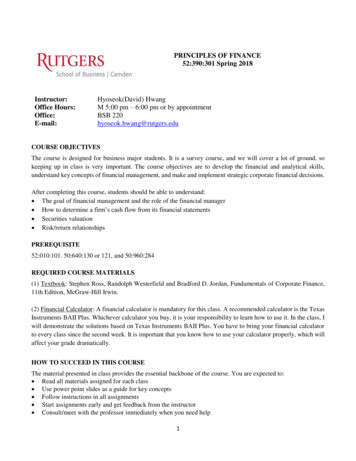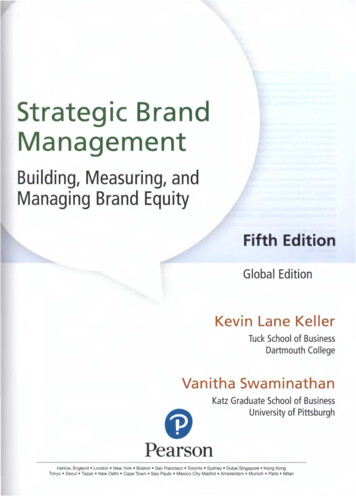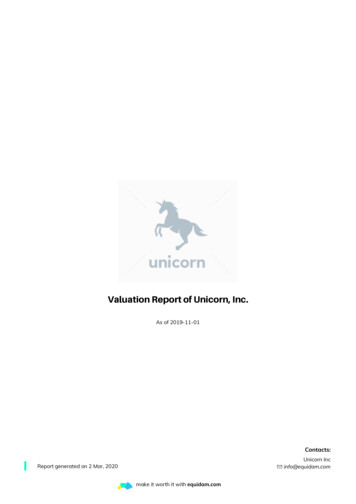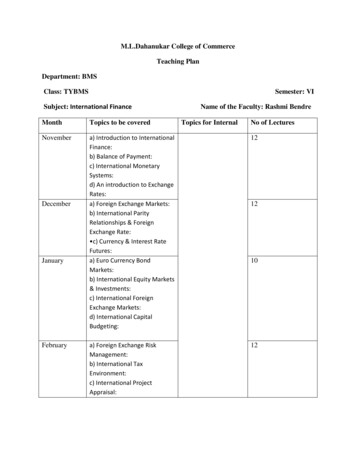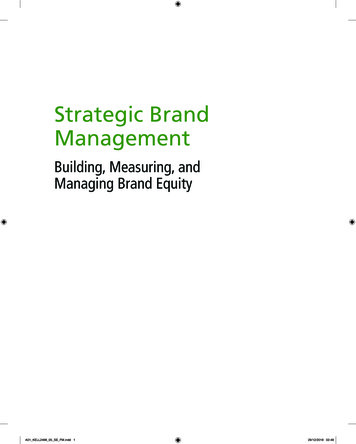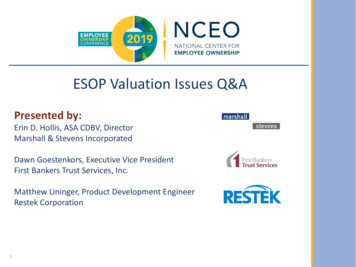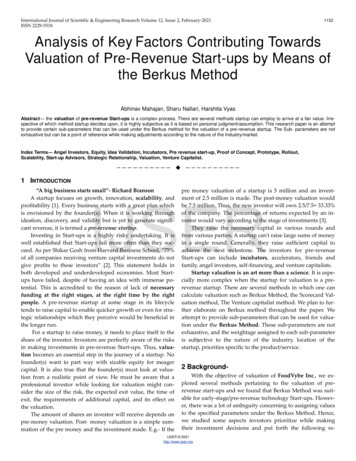
Transcription
Brand Valuation:Measuring andLeveraging yourBrandby David Haigh Chief ExecutiveBrand Finance plc
Brand Valuation: Measuring andLeveraging your BrandA report prepared for theInstitute of Canadian AdvertisingPrepared byDavid HaighChief ExecutiveBrand Finance plc B r a n dF i n a n c ep l cM a y2 0 0 01
B r a n d V a l u a t i o n : Me as ur i n g a n d L e ve r a g i ng y o u r B r a n dForeword“It is now uniformly accepted that companies which are good at marketing produce better resultsover time for their shareholders than those which aren’t. It is our firm belief that the essence ofgood marketing is the development and promotion of long term brands.Brands add intangiblevalue to products and businesses and redefine the value of their company owners.A new recognition of the financial value of brand assets is now emerging in company boardroomsand on Bay Street.While the brand owner must take ultimate responsibility for brand fortunes,and the role of the advertising agency in creating and sustaining brand power should not beunderestimated.The debate around brand valuation is a healthy one, in so far as it puts brand discussion firmly onthe Boardroom agenda. It can also serve as a useful background to strategic and brand planningand control.In exploring these issues, we are sure that this new ICA booklet will prove invaluable.David Harrison, Chairman ICA2 B r a n dF i n a n c eRupert Brendon, President ICAp l cM a y2 0 0 0
ContentsForewordBrand Finance: an introductionThe Author - David Haigh, Chief Executive, Brand Finance plc1.Intangible assets: driving corporate value in the 21st Century2.Recent developments in brand valuation3.Brand economics: how brands add value4.Best practice in brand valuation5.Applications of brand valuation5.1 Strategically orientated brand evaluations Portfolio review and brand architecture Resource allocation Brand performance tracking New product development Internal communications5.2 Financially focused brand valuations Balance sheet reporting Litigation support Fair trading investigations Tax planning Merger and acquisition planning External investor relations Licensing and franchising Securitized borrowing Agency performance evaluation6.How can advertising agencies contribute to the brand valuation process?7.Current accounting treatment of brands8.Investor requirements in terms of marketing disclosureAppendix 1 Brand EquityA1.IntroductionA2.Brand Asset Valuator (Young & Rubicam)A3.BrandDynamics (Millward Brown)A4.BrandBuilding (NPD)A5.Brand Equity Tracking (Tandemar)A6.Using brand equity research in brand valuationsA7.The Brand Equity Ten (David Aaker) B r a n dF i n a n c ep l cM a y2 0 0 03
B r a n d V a l u a t i o n : M e as u r i n g a n d L e ve r a gi ng y o u r B r a n dBrand Finance is a specialist consultancy dedicated to the better understanding of marketing finances. It is entirely independent andoffers a highly professional approach to marketing accountability and brand valuation. Brand Finance has developed transparent andaccessible brand valuation methodologies grounded in leading-edge marketing and investment practice.Services designed to maximize value in marketing and branding include brand audits, brand equity research,brand performanceforecasting, brand valuation, brand portfolio review, budget allocation strategy, agency remuneration, accounts payable andproduction cost audit,and advice on related information technology and training.Brand Finance works for a wide range of blue-chip clients conducting national and international brand valuation and strategyassignments. Sectors covered include food, confectionery, alcoholic drinks, automotive, telecommunications, oil, banking andinsurance, chemicals,and leisure/ retail.For further information on Brand Finance and its approach to marketing finance contact:Brand Finance plcTel: 44 (0) 20 8943 inance.comThe AuthorDavid Haigh, Chief Executive, Brand Finance plcDavid Haigh read English at Bristol University before qualifying as a Chartered Accountantwith Price Waterhouse in London. He worked in international financial management thenmoved into the marketing services sector, firstly as Financial Director of The CreativeBusiness and then as Financial Director of WCRS & Partners.He left to set up a financial marketing consultancy which was later acquired by Publicis,the pan European marketing services group, where he worked as a director for 5 years.He moved to Interbrand as director of brand valuation in its London-based global brandvaluation practice, leaving in 1996 to launch Brand Finance.David is a fellow of the UK Chartered Institute of marketing and was a member of the1998 IPA Advertising Effectiveness Awards judging panel.He is author of ‘Strategic Control of Marketing Finance (FT/Pitman Publishing 1994), ‘Brand Valuation - a review of current practice’ (IPA,1996), ‘Brand Valuation’ (FT - Retail and Consumer Publishing, 1998) and ‘Understanding the Financial Value of Brands’ (EAAA, 1999).4 B r a n dF i n a n c ep l cM a y2 0 0 0
1. Intangible assets:driving corporate valuein the 21st CenturyMarketers have been committed to building brands for more than a century. However, operating efficiency and financialperformance were the preferred measures of performance in board rooms and investment houses during the bulk of the 20thcentury. This was an understandable approach in an era when product differentiation was achieved in factories and the bulk ofa company’s value was reflected by its fixed assets. The era passed, but the financial and operating focus remained.Advertising budgets increased as communications mediums became more powerful and numerous. This trend was exacerbatedby technological developments which resulted in a greater range of similar products, and the resulting difficulty in functionaldifferentiation. The growing budgets were a tacit acceptance that ‘advertising works’, yet it was not accepted as being at thecore of a business by those in control of the purse strings. The shift in the relative importance of tangible and intangible assetsescaped the attention of the accounting profession and most investment analysts.Marketers were silent accomplices to this omission. They focused on their own functional area of expertise, confident in itsimportance, and measured their performance in terms that were not appreciated by the broader commercial community.Investors and accountants remained unimpressed by measures of brand strength which were measured in perceptual ratherthan financial terms.In the late eighties many investment analysts and fund managers were still basing investment decisions on traditional measuresof financial health, principally earnings per share, dividend yield and balance sheet asset values. Such measures canfundamentally misstate corporate value.The main impetus for an acknowledgement of the value of brands, and other intangible assets, came from the corporate raidersand asset strippers of the eighties who targeted brand rich companies and paid significantly more than their net asset value.This resulted in huge ‘goodwill’ values which had to be accounted for. Alarm bells rang in the boardrooms of many underperforming branded goods companies as directors realized there was a clear need for a method of accounting for brands whichwould recognize their true value in the balance sheet, and avoid arbitrary write-offs which damaged investor perceptions.A realization that the full value of brand owning companies was neither explicitly shown in the accounts nor always reflected instock market values led to a reappraisal of the importance of intangible assets in general, and brands in particular. This in turnraised the question of how such assets should be valued and disclosed. Although the accounting profession has only partiallyadapted to a world in which intangible assets are the main drivers of value, business leaders and investors have been quickeroff the mark.There is currently a global merger and acquisition boom in progress. Brands have played a significant role in this activity.Mannesmann, for example, has agreed to pay nearly US 20 billion for a mobile phone brand that has only been in existence forfive years. Within its home market Orange boasts higher customer acquisition, retention and usage rates than its rivals – all keyfactors of a successful brand. Orange has achieved that magic ingredient which positions it as a lifestyle brand. It has alreadybeen licensed into new geographies and is tipped to move into other product categories.Instances such as this bring the value of specific brands into the public domain, but the bulk of intangible asset value remains‘off balance sheet’. A recent research study carried out by Brand Finance indicates that brands and other intangible assets nowcontribute the bulk of shareholder value in many sectors. This UK based study reviewed the annual reports of 344 of the FTSE350 companies with year-ends up to and including 31st December 1998.It seems bizarre that 72% of the value of the companies surveyed was not reflected in published balance sheets. Thispercentage varies considerable by sector highlighting the varied importance of intangible assets between sectors. B r a n dF i n a n c ep l cM a y2 0 0 05
B r a n d V a l u a t i o n : M e a s ur i n g a n d L e v e r a g i n g y o u r B r an dGap between FTSE 350’s market capitalization and net asset value at 31/12/98Brands form a significant part of this ‘unexplained value’. Other intangibles such as patents, customer lists, licenses, know how andmajor contracts also play a role. Patents, for instance, are a major component of value in the pharmaceuticals sector.Brands will be major drivers of corporate value in the 21st century. Investors and business leaders have recognized this. Marketersare increasingly using brand valuation models to facilitate marketing planning.They should go one step further. Investors need andwant greater disclosure of brand values and marketing performance.Marketers should play a lead role in ensuring that suchinformation is adequately communicated to investors, rather than waiting for statutory disclosure requirements to catch up withreality.6 B r a n dF i n a n c ep l cM a y2 0 0 0
2. Recent developmentsin brand valuationDuring the last five years,brand valuation has become a mainstream business tool used for the following purposes: Merger and acquisition planningTax planningSecuritised borrowingLicensing and franchisingInvestor relations Brand portfolio reviewsMarketing budget determinationResource allocationStrategic marketing planningInternal communicationsA particular trend has been the increasing use of brand valuations as a tool to aid marketing management. The focus here is toincrease the effectiveness of the marketing effort and aid brand management. A prime benefit in this regard is the fact that a brandvaluation model is linked to the company's business model and provides a financial measure that is understood throughout theorganization and by investors.A well-constructed brand valuation pulls together market research, competitive data and forecasts of future performance. Thisincreases the understanding of the brand’s value and its contribution to demand in each segment and identifies opportunities forleveraging the brand. A dynamic brand valuation model can be used for scenario planning purposes.The ability to place a financial value on a brand within each key market segment is not the only output of a valuation study: Research into the drivers of demand yields information that aids a range of decisions, including portfolio planning andproduct positioning. It can help define the focus of the advertising message. An identification of causal relationships within the business model facilitate an increase in advertising effectiveness. The competitive benchmarking study that forms part of an assessment of the risk attached to future earnings provides agauge of the brand’s strength, in relation to competitors, from segment to segment.Some examples of internally focused brand valuations that Brand Finance has carried out during the last two years are shown below.The first example illustrates the use of a brand valuation to help resolve a specific issue. The impetus for the project had been theacquisition by a global financial services company of a number of new brands. This had resulted in a cluttered portfolio which requiredrationalization. The brand valuation was segmented by product and customer for all of the group’s brands in the UK, Europe,Australia,Hong Kong and the US. The project formed the framework to inform brand rationalization and brand architecture decisions.In the case of a retail bank, a brand evaluation project was carried out in order to assess the contribution of the brand in the corporate,as opposed to the consumer, market segment. The study was also segmented by major product groups. Consumer research wascommissioned to quantify the drivers of demand. The study impacted on the allocation of marketing resources between marketsegments and was applied to measure the effectiveness of marketing investment.A global insurance company provides an example of a valuation initially carried out for a specific purpose, but that has now beenrepeated. In this instance, brand valuation and competitor benchmarking techniques were combined to determine the optimal globaladvertising investment behind the client’s corporate brand. The results were used by senior management to set corporate advertisinglevels. Periodic repetition of the exercise has been used by management to understand and monitor the effect of brand investmentdecisions on corporate brand value.In the case of a listed food manufacturer, a brand valuation was conducted in order to communicate the value of the company’s mainbrand to analysts and investors. Management commissioned the study as they believed the shares were undervalued and thecompany vulnerable to takeover.A major tobacco company illustrates the use of a brand valuation model on an ongoing basis. The corporate marketing finance teamcommissioned the constructing of a brand evaluation model to monitor the performance of key client and competitor brands in localmarkets and at a global level. The brand valuation has been placed on the company’s intranet and is supported by a manual which B r a n dF i n a n c ep l cM a y2 0 0 07
B r a n d V a l u a t i o n : M e a s ur i n g a n d L e v e r a g i n g y o u r B r an dclarifies what information is required to be inputted into the model and how the results can be used.The model is kept up to date byoperating companies in sixty countries.The data produced by the model informs local decision making as well as group planning.These examples show the range of internal uses of brand valuation studies. Further discussion in this regard is provided in section5.1 of the report.Many organizations suffer from a surplus rather a than lack of market and consumer information. Unfortunately much of this isgathered and stored in isolation.The old functional boundaries of a bygone era still prevent the effective flow and integration ofinformation. Even if brand tracking data makes it onto the intranet or a shared directory, it tends to remain in ‘research speak’ andtends not to be used by financial and strategic planners.A successful brand valuation project relies on input from both the financial and marketing teams of a company. It will result in amodel that gathers and integrates market, consumer and financial data.The integration of such data into a coherent business model,and the fact that the data sources are ‘cross functional’ make it significantly more useful,and more used, than each of the datasources in isolation.It must be stressed that the depth and extent of a brand valuation can vary. This is illustrated by the following diagram.One of the key differences between a static and dynamic valuation model is the extent of consumer research that is used. The simplervaluations only focus on research which enables an assessment of the brand’s contribution to the purchase decision to be made. Dynamicbrand valuation models require a more detailed understanding of the consumer’s relationship with the brand. This allows causalrelationships within the business model to be identified and quantified. Dynamic brand valuation are discussed in section 4.The brand valuation model should provide a central framework for a marketing information system.All data within the brand valuation model, as well as the outputs, should be easily accessible either at a top level or through a ‘drilldown’ facility.If a brand valuation model is being used for ongoing tracking purposes it is essential that responsibility for inputting new data is clearlydesignated. It is usually necessary to have both marketing and finance involvement in this, however, in some organizations a single‘home’, for instance the marketing finance team, is found.This is not to say that a well constructed brand valuation meets all the information requirements for marketing decision making.Qualitative research and tools such as perceptual mapping will always be necessary. A brand valuation model often provides inputs toother marketing tools and processes.8 B r a n dF i n a n c ep l cM a y2 0 0 0
3. Brand economics:how brands add valueAs illustrated by the following chart, heavily branded companies have a history of outperforming the Canadian market.A similar performance gap between heavily branded companies and the market index is apparent in the US and UK.How do brands add value? In economic terms the answer is simple.They impact on both the demand and supply curves.On the demand side brands enable a product to achieve a higher price at a given sales volume. Strong brands can also increase salesvolumes and churn rates. Price and volume impacts are in some instances achieved at the same time. An example, taken from theEconomist, is of the GEO Prizm and Toyota Corolla in the US. These vehicles are virtually identical, coming off the same production lineand having similar levels of distribution and service levels. However, the Corolla trades at an 8% premium and sells double the volumes.Brands also establish more stable demand, through their relationship with consumers.They establish barriers to entry. Therelationship with consumers is due to both functional and emotional attributes. On the functional side brands ensure recognition andfurther aid the purchase decision through a guarantee of quality. From an emotional perspective they satisfy aspirational and selfexpression requirements.This is most evident in luxury and fashion sectors.A further benefit of branding which has increased in importance in recent years,is the ability to transfer the equity or valuesassociated with a brand into new product categories. In order for brand stretching to be effective, it is necessary that the core valuesof the brand are image, rather than product, based.Whilst there are numerous examples of successful brands that have achieved significant price premiums or higher volumes,theimpact of branding on the supply curve is often ignored. Brands tend to shift the supply curve downwards due to the followingreasons: Greater trade and consumer recognition and loyalty. This results in lower sales conversion costs and more favorablesupplier terms. Lower staff acquisition and retention costs. Lower cost of capital. Economies of scale achieved through higher volumes. B r a n dF i n a n c ep l cM a y2 0 0 09
B r a n d V a l u a t i o n : Me as ur i n g a n d L e ve r a g i ng y o u r B r a n dThere is an increasing body of research supporting the fact that successful brands add corporate value. There are, of course,examples of successful brands that have fallen from grace and branding initiatives that have failed.The challenge is to identify howyour brand,or your client’s brand, impacts on the business model, and to monitor whether marketing strategies are successful inadding value to the brand.10 B r a n dF i n a n c ep l cM a y2 0 0 0
4. Best practicein brand valuationA number of methods can be used to value brands.Cost based brand valuations are rarely used as the cost of creating a brand tendsto have little similarity to its current value. Market based comparisons, on the other hand, are unsatisfactory as a primary method ofvaluing a brand because comparative data is scarce and brands are unique.However, where available, market comparisons areuseful for testing primary valuations.A more commonly used approach is the royalty relief method.This is based on the assumption that if a brand has to be licensedfrom a third party brand owner, a royalty rate on turnover will be charged for the privilege of using the brand.By owning the brandsuch royalties are avoided.The royalty relief method involves estimating likely future sales and then applying an appropriate royaltyrate to arrive at the income attributable to brand royalties in future years.The stream of notional brand royalty is discounted back toa net present value – the brand value.Although the royalty relief method is technically sound, it provides little understanding of how and where the brand is creating value.It might therefore be an appropriate method of valuing a brand for balance sheet or tax purposes,but will be of limited use to amarketing director wishing to leverage the value of a brand.The economic use method integrates consumer research and competitive analysis with the brand’s forecast earnings.As such itprovides a foundation for brand management in addition to determining the value of the brand by market segment.As this method isof most interest to marketers, and is the most widely used method of brand valuation, it is discussed in more detail.The Brand Finance methodology has been used by leading brand owners across the world and will be used to illustrate a marketingorientated valuation. A snap shot of this valuation framework is provided below:The focus is on the return earned as a result of owning the brand – the brand’s contribution to the business, both now and in thefuture.This framework is based on a discounted cash-flow (DCF) analysis of forecast financial performance, segmented into relevantcomponents of value.The DCF approach is consistent with the approach to valuation used by financial analysts to value equities and by accountants totest for impairment of fixed assets (both tangible and intangible) as required by new international accounting standards. B r a n dF i n a n c ep l cM a y2 0 0 011
B r a n d V a l u a t i o n : M e a s u r i n g a n d L e v e r a gi ng y o u r B r a n dFor some purposes market base valuation or the royalty relief method of valuation may be possible. However, DCF valuation is themost widely accepted approach to brand valuation and provides a greater depth of understanding of the dynamics of the brand.While brand valuations can be based on a multiple of historical earnings it is clear that past performance is no guarantee of futureperformance and that investors base value judgements on expected future returns rather than actual historical returns. However,historical results are crucial for accurate valuation mainly because they provide information and data relationships which help tomore accurately forecast the future.Valuations based on projected earnings are therefore our preferred approach with the caveat that forecasts must be credible. Whereforecasts are credible the valuation results are both robust and actionable.A brand valuation study typically consists of four work streams: Financial forecasts Brand Value Added BVA - analysis of the brand's contribution to demand ßrandßeta analysis - determination of the risk attached to future earnings Valuation and sensitivity analysis.The BVA section of the analysis can be extended to incorporate a study of causal relationships within the business model.Thisfacilitates the development of a dynamic brand valuation model, as discussed in section 4.6.Prior to commencing these studies it is necessary to decide on the most appropriate level of segmentation.4.1 SegmentationIn applying the valuation framework one of the first and most critical tasks is to determine the nature of the segmentation forvaluation purposes. It is then important to identify how internal financial and marketing data, and external market and competitordata, can be obtained in a way which fits with the chosen segmentation.The principles behind effective segmentation for brand valuation purposes are as follows: Homogeneous geographic, product and customer groupings to ensure that the valuations are relevant to defined targetmarkets.Clearly definable set of discrete competitors in each segment to ensure that we are comparing apples with apples.Availability of market research data to match the chosen segmentation.Availability of volumetric and value data for competitor brands to match the chosen segmentation.There is little point in choosing a valuation segmentation based on an aggregation of product or customer groupings which obscuresimportant underlying differences.Equally, there is little point in choosing a particular detailed segmentation against which it is impossible to obtain volumetric or valuedata to the appropriate level of detail. Without these it may be hard, if not impossible,to estimate relative market shares and tocompare performance and forecasts against competitors.Much of the success of a brand valuation lies in the selection and planning of the relevant segmentation and the sourcing of suitabledata.A dilemma in relation to customer segmentation is that below the broad categories lie many more specifically defined demo, socio orpsychographic sub-segments. The marketing and market research teams may well want to ‘drill’ down to a more detailed level forNPD or communications planning purposes while the valuation may need for practical reasons to be cut at a higher, moreaggregated level. It is often impossible to sub-segment the financial valuation to the same level of granularity that may be desirablefor a market mapping segmentation. The brand valuation team therefore needs to ensure that the segmentation for the valuationcascades up from a more detailed underlying segmentation if one is used.12 B r a n dF i n a n c ep l cM a y2 0 0 0
Another difficulty in relation to product segmentation is that volumetric or value measures for each product group may be hard orimpossible to obtain particularly in less well developed or defined product and service areas or countries. It is also common to findthat in some client segments it is hard to obtain reliable data for total market size, as competitor data may be unavailable. Apragmatic approach and a medium term strategy to populate data gaps may be required, allowing subsequent years valuations tohave an increasing level of detailed comparative analysis.The difficulties of selecting and populating the chosen segmentation with data have been noted to highlight the need for care andexperience in planning and constructing the brand valuation.4.2 Financial ForecastsTypically, explicit forecasts for periods of 3-5 years are used for such valuations and should be identical to internal managementplanning forecasts.An important part of the brand valuation process involves ensuring that forecasts are credible.Forecast revenuesMacro-Economic ReviewIt is necessary to conduct extensive due diligence on each of the markets in which the brand operates to ensure the valuation takesinto account all the macro-economic factors likely to affect the level of demand for the brand.These could be technological,structural, legislative, cultural or competitive.The brand valuation exercise needs to consider the likely trends for both volume and value for the market as a whole and for thebrand being valued.This often involves detailed discussion between the brand valuation team and internal competitor analysis,corporate strategy, market research and marketing departments.Micro-Economic ReviewIt is necessary to consider the factors that have historically affected the performance of the brand in each of its markets.This can involve econometric modeling or some other form of statistical analysis of past performance to show how certain causalvariables have affected revenues.One of the key issues in terms of branding is to understand the causal relationship between total marketing spend,pricing and salesresults. It is equally important to understand the relative effect of different media on the overall level of sales.The task of the brand valuation team is therefore to ensure that brand and marketing factors are being accounted for properly in themodeling and analysis taking place, and that results are used to obtain the most appropriate forecast sales values.In the same way that it may be desirable to use econometric analysis of past influences on sales it may also be appropriate to useprojective price elasticity research to predict the effect of price on sales. B r a n dF i n a n c ep l cM a y2 0 0 013
B r a n d V a l u a t i o n : M e a s ur i n g a n d L e v e r a g i ng y o u r B r an dPrice elasticity modeling of this type is typically based on large sample quantitative research and is used to improve the accuracy offuture sales forecasts. To the extent that this is not already being done we recommend that this should be considered as an input tothe brand valuation process to help refine forecast earnings.Forecast costsIt is necessary to understand fully the basis on which forecast costs have been determined.The brand valuation team will need toconfirm that the basis of cost allocation is sensible between each of the geographic, product or customer segments on a current andforecast basis.The same principle applies to the allocation of capital to different segments and the resulting charges for capital
forecasting, brand valuation, brand portfolio review, budget allocation strategy, agency remuneration, accounts payable and production cost audit,and advice on related information technology and training. Brand Finance works for a wide range of blue-chip clients conducting national and international brand valuation and strategy assignments.
